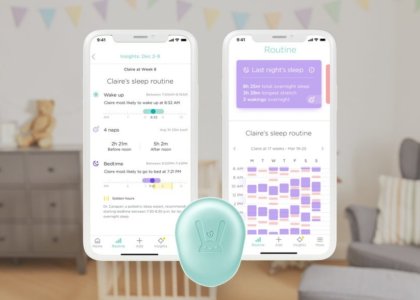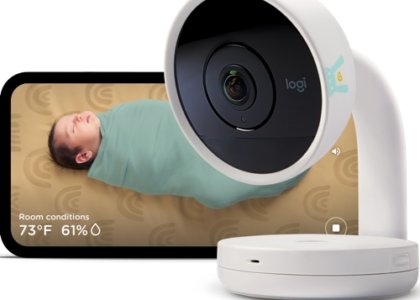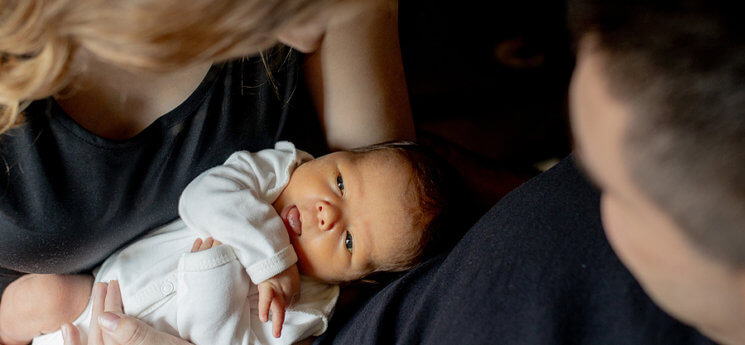Bringing a newborn baby home from the hospital can be one of the scariest moments in a new parent’s life. From the moment when you went into labor, you had a team of health professionals swarming about, ready to meet your every need. Now, they’re gone, and it’s just you and the baby. This can be a nerve-racking and confusing time for many new parents, but it doesn’t have to be.
The most important thing to do is relax and enjoy your experience with this new little person. However, a few insights and tips can help you make a smooth transition from hospital to home.
Infant Sleep: Setting a Baby Sleep Schedule
For the first two weeks, your infant will sleep 16-17 hours per day, in intermittent bursts. This is normal as her brain adjusts to the new demands of living outside the womb. This is the period that most parents find challenging, as the baby’s sleep patterns conflict with their own. It is important during this time to set a regular baby nap and sleep schedule.
There are several methods for setting a baby’s sleep schedule, but the most effective way is to follow your baby’s needs. You can get the Lumi by Pampers Smart Sleep System which features a smart sleep sensor and comes with a wide variety of features, including direct access to virtual sleep coaching videos. The pediatrician-developed video series provides useful advice for creating a nap and sleep schedule for infants from newborns to 16 months old. The coaching feature includes access to short step-by-step instructional videos that explain the fundamentals of putting your baby to sleep.
Also, this smart sleep system generates vital information on your baby that can be viewed on the app which features state-of-the-art encryption for your peace of mind. It tells you when the baby went to sleep, the baby’s average sleep time, the diaper condition, allowing parents to make adjustments to their baby’s nap and schedule and track their baby’s sleep cycles 24/7 and observe how their baby progresses over time.

In addition to a sleep system, one of the best investments you can make to establish a schedule, regardless of the method, is a high-quality baby monitor. Baby nursery monitors allow you to visibly check on your baby for peace of mind, and soothe them back to sleep when necessary. Lumi by Pampers is the latest in smart baby monitor technology. It features a 180° view and 1080p HD display, so you receive crystal clear images of your little one directly to your phone in real-time. The audio comes with 2-way communication, allowing you to talk to the baby from anywhere in your home, using the accompanying app. The audio continues to work even if you are using other apps or have the screen locked.
Once you have the information you need to nurture a healthy sleep routine for your family, here are some helpful sleep recommendations for the baby’s schedule:
- Put her on her back to sleep.
- A newborn should have 1-2 hours of napping, for every 1-2 hours awake.
- Babies love to be reminded of being in the womb, so rocking them while swaddled firmly can help her to sleep.
Wake Time
When your baby is awake, spend time getting to know him. Talking to the baby enables them to recognize your voice. It also helps with language development. The more language they hear during the infant stage, the easier their experience during the toddler years when they try it on their own.
Crying is a natural form of communication, although figuring out the source of infant distress can be frustrating for a new parent. Once you get to know your baby, you will find the cries take on different tones. She will have a hungry cry, a tired cry, or an I want to be held cry. Most babies’ cries are responses to physical needs. If you can’t figure out what’s wrong, check:
- Could he be hungry?
- Is the diaper soiled?
- Is she in pain?
- Is she lonely?
- Is he overstimulated?
- Is she overtired?
During the infant wake time, there are several behaviors that are entirely natural and part of the baby’s development.
- Throw arms and legs about; a newborn has no motor control, so most movements are reflexes.
- Tremors when stretching or diapering.
- Curl up in a fetal position because it was a comfortable position from the womb.
- Sometimes short pauses between breaths.
- Odd noises, such as gurgling, sneezing, grunting or even squeaking.
Of course, you can’t spend every waking moment observing your baby’s behaviors. But it is important not to miss out on learning your baby’s unique non-verbal communication and cues. The Lumi by Pampers Smart Baby Monitor has a reliable wide-reaching WiFi connection that gives you access to the app from any room in your house, so you can check your baby regularly even if you have other tasks to do around the house. It also comes with a Lookback feature that shows you a time-lapse video of your baby’s daily activity which is ideal for keeping as a memento alongside your baby book, or to send to friends and family far away.
Feeding Schedule
 Newborns need to eat every 2-4 hours, depending on whether they are breast or bottle fed, growth patterns. The AAP recommends that parents feed newborns on demand, which requires parents to cater to the baby’s needs by picking up on subtle hunger and satiety cues. However, as your baby gets older, you can start to develop a more structured schedule.
Newborns need to eat every 2-4 hours, depending on whether they are breast or bottle fed, growth patterns. The AAP recommends that parents feed newborns on demand, which requires parents to cater to the baby’s needs by picking up on subtle hunger and satiety cues. However, as your baby gets older, you can start to develop a more structured schedule.
If your newborn baby is asleep, it is recommended to wake them, so they don’t miss a feeding. Whether you are breastfeeding or using formula, your doctor will have advised you on proper feeding techniques.
If you are breastfeeding, especially for the first time, you may need to educate yourself on the best techniques and how to build your milk supply. You will need to know what to do for common problems like a clogged milk duct or a forceful let-down. These are easily treatable but can be painful and frustrating for both you and the baby if you don’t know the signs.
Newborns have tiny stomachs, so in the beginning, your feedings may be short. For a newborn infant, feeding is 1-3 ounces at a time for the first 1-2 weeks of life, but by 2 months old they should be consuming around 3-4 ounces per feeding. However, your baby knows when they have had their fill and often naturally pull away from the bottle or the breast when their stomachs are full. They will also need to be burped regularly.
Burping happens when the baby swallows too much air during feeding. Although some infants burp on their own, many may need assistance. There are several different burp positions. After a day or two of practice, you’ll find the positions that work for you. Some helpful tips for feeding and burping include:
- Always keep a cloth on hand during feeding for unexpected soiling.
- When burping, put a cloth to protect your clothes.
- If a baby starts to fuss during feeding, it could likely be they have excess wind. Try burping to see if that helps.
- When breastfeeding, it is a good idea to stop and burp when changing breasts.
- There is no need to be vigorous with your burping. A soft pat or circular motion will usually do.
- Experiencing excessive spit-up is a symptom of acid reflux or GERD. This is common and easy to treat, but you will need to contact your pediatrician.
Diapering
The hospital will have shown you how to diaper your infant correctly. But a good rule is to check the diaper about an hour after every feeding. In the first month, you should expect to change at least five diapers a day for a breastfeeder, and ten per day for a formula feeder.
If a soiled diaper is left on too long, it can cause a diaper rash. This is a reddened area in the diaper area that looks and feels like a sunburn. This is easy to alleviate and soothe with an over-the-counter ointment, but some babies have more sensitive skin and are more prone to diaper rashes than others.
The Takeaway
The most important rule of taking a baby home is to relax. They are more resilient than they look, and as a new parent, you will make plenty of mistakes. With award-winning technology like the Lumi by Pampers Smart Baby Monitor + Smart Sleep System, it won’t be long before you both find your rhythm.




